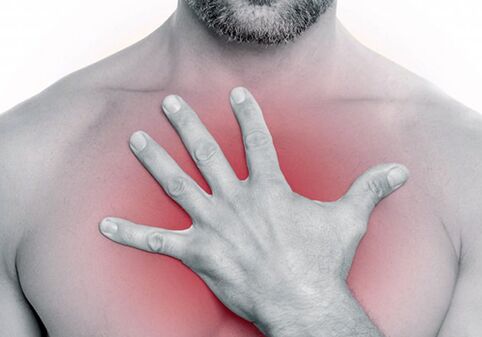
Degenerative and dystrophic changes in the vertebral tissue and intervertebral discs, and the clinical symptoms associated with this process, are called osteochondrosis.Let's consider the main causes and methods of treatment of osteochondrosis of the thoracic spine.
Causes of osteochondrosis of the thoracic spine
- Ancestry.
Defective or mutated genes responsible for normal bone growth are inherited.Therefore, the risk of osteochondrosis increases significantly if someone in the family suffers from this disease. - Sedentary lifestyle.
In this case, a prolonged and excessive load on the spine is important, which leads to compression of the vertebrae and the development of the disease.This happens more often among people who work on computers and among drivers. - Vascular pathology.
Any disease of the vessels that supply the spinal column with blood and cause an insufficient supply of nutrients to the vertebral tissue leads to the appearance of degenerative and dystrophic changes in it. - Metabolic disorders in the body.
Often, diabetes mellitus leads to changes in blood vessels that disrupt tissue trophism.In addition, direct changes in the vertebral tissue are possible in cases of disturbances in phosphorus-calcium metabolism, in pathology of the thyroid and parathyroid glands, and diseases of the adrenal cortex. - Infection and intoxication.
Inflammatory processes in the tissues of the vertebral and intervertebral discs, caused by viruses, bacteria, or the action of their toxins, can also lead to the development of osteochondrosis. - Excess body weight.
The presence of constant overload on the spine leads to compression of the intervertebral disc with the subsequent development of the underlying osteochondrosis process. - Poor nutrition.
Micro deficiency (for example, calcium), vitamin deficiency (D3) can also cause disruption of metabolic processes in the body and the development of bone and cartilage tissue pathology. - Age-related changes in bone and cartilage tissue.
With age, degenerative changes occur in the thoracic spine, which leads to compression of the intervertebral discs.In old age and old age, the muscular frame of the spine also weakens. - Thoracic spine injury.
Bruises and fractures of the vertebral arch due to falls or auto injuries are not such a rare occurrence.At the same time, anatomical changes in the vertebrae and surrounding tissues are the direct cause for the development of the pathological process, which is the cause of osteochondrosis. - Scoliosis
"School" pathology, which develops in children of educational institutions where health-saving technologies are not used, occurs mainly in the thoracic spine.The curvature of the spine seems to change the load on individual segments of the spine, which causes the development of osteochondrosis. - Sports and occupational hazards.
Sports stress (for example, weight lifting), as well as work related to lifting weights, frequent changes in body position (turns, flexion and extension, jerking movements) can also cause persistent pathological changes in the spine.In addition, prolonged exposure to uncomfortable postures in standing, sitting, lying down, when lifting and carrying heavy objects, or when doing other work, which increases the pressure in the disc and the load on the spine as a whole, can also cause osteochondrosis. - Other causative factors and risk of developing osteochondrosis of the thoracic spine.
Spinal overstrain associated with foot disease, and also as a result of wearing uncomfortable shoes, high heels and pregnancy in women, the sharp cessation of regular training by professional athletes and, finally, nervous tension and stressful situations.
Symptoms of osteochondrosis of the thoracic spine
All symptoms of the disease can be divided into reflex and compression.
Reflex symptoms
The mechanism of their appearance is the irritation of intervertebral ligament receptors, intervertebral joint capsule, and intervertebral disc receptors.Irradiation (spread) of irritation to adjacent segments of the spinal cord can cause the appearance of various symptoms.
Here are the main ones: pain in the chest, pain in the stomach or in the heart area, tension in the chest muscles, vegetative symptoms of the internal organs.The pain is always sharp, described by the patient as a blow from a knife.The place of pain is the area between the shoulder blades, the pain can radiate to the area of the heart, sternum.
It can be difficult for the patient to move or take a deep breath.Reflex symptoms in osteochondrosis of the thoracic spine are more common than compression symptoms.
Symptoms of compression
Compression symptoms of osteochondrosis of the thoracic spine are caused by compression or stretching of the nerve root in the area where it exits the intervertebral foramen.The main ones are: symmetrical muscle weakness in both legs, loss of sensation in them, "radicular" pain in the back and chest.The pain is "shooting", felt in the chest, in the abdomen, increases with movement, bending over, coughing, sneezing, laughing.Feelings of "crawling", numbness, and tingling appear.As the pathology progresses, movement disorders and muscle atrophy may appear.Muscle tone increases, sensitivity in the lower part of the legs decreases, and urinary disturbances may appear.
Other autonomic symptoms of osteochondrosis of the thoracic spine
Autonomic symptoms in osteochondrosis appear due to the fact that nerve fibers coming from the thoracic spine contain autonomic conductors;Irritation or violation of these fibers can be accompanied by autonomic symptoms.The main ones are: peeling and dry skin in the conservation zone of compressed nerves, local disorders of sweating and thermoregulation (also according to the conservation zone), brittle nails, pain simulating the pathology of the gastrointestinal tract (gastritis, lower gastritis.
Treatment of osteochondrosis of the thoracic spine
Treatment of osteochondrosis of the thoracic spine should be comprehensive (with a combination of medical and non-medical methods), individual and systemic.
Drug treatment methods for osteochondrosis of the thoracic spine
The main objective of this method is to eliminate pain, muscle tension, improve microcirculation and tissue trophism.For this purpose, non-steroidal anti-inflammatory drugs are used to reduce inflammation, relieve pain and muscle tension.These funds are set for an average of 7-14 days.Application of local anesthetic is prescribed.In cases of insufficient non-steroidal analgesic effect, analgesic mixtures are used.The mixture is given intravenously using saline or glucose.Paravertebral block has a rapid analgesic effect, when the analgesic is injected into the soft tissue of the perivertebral area.
To relieve pain in osteochondrosis of the thoracic spine, irritating and irritating ointments are used topically.
Muscle tension is relieved with drugs such as muscle relaxants.
To normalize blood circulation and improve tissue nutrition, antiplatelet drugs and nicotinic acid are used.
They also use drugs that increase metabolism in the intervertebral discs and joints - chondroprotectors.
Non-drug treatment
Diet for osteochondrosis of the thoracic spine.Completely excluded from the diet: salt, hot spices, preparations using vinegar and salt, semi-finished products, sugar (can be replaced with honey), coffee and carbonated drinks.Allowed: legumes, eggplant, cheese, dairy products, lettuce, cabbage, cottage cheese, bananas, liver, carrots, melons, seafood, grains, fresh vegetables and fruits, herbs, seeds and berries.
A complex treatment program for osteochondrosis of the thoracic spine includes: manual therapy, classical massage, acupressure, reflex-segment massage, physical therapy, torsion techniques (stretching), acupuncture, swimming, physiotherapy methods (electrophoresis,
Traditional methods of treating osteochondrosis of the thoracic spine

Increased osteochondrosis of the thoracic spine is an indication for treatment under the strict supervision of a doctor.Home and folk remedies should not be used blindly, without a doctor's permission.The following can be used as additional treatment to alleviate the patient's condition:
- Tinctures and decoctions.
- Tincture of lingonberry leaves.Take 1 tablespoon of lingonberry leaves, pour 0.25 liters of boiling water and let it brew for 2 hours.Drink half morning and evening for 3 weeks.
- Boil parsley root.Grind 50 g of parsley root, add 0.5 liters of water and simmer on low heat for one and a half hours.Eat 1 tablespoon morning and evening for 3 weeks.
- Tincture of Nettle and Honey.Apply juice from freshly picked nettles, mix with honey and medical alcohol in equal parts.Leave it in a cool place for 14 days and eat a spoonful in the morning on an empty stomach for 2 weeks.
- Yarrow Tincture with Mint, Licorice and Calendula.Mix a spoon of yarrow and 2 spoons of mint, licorice and calendula and pour 1 liter of boiling water, let it soak for 7-8 hours.Take 50 ml 3 times a day for 3 weeks.
- Scrub.
- Radish and honey infused with vodka.Grate carrots, mix with honey in equal parts and add 50 ml of vodka.Use this composition to rub on the site of pain.
- Lard and hops.Mix a tablespoon of lard melted and cooled to room temperature with the same amount of ground hops.Rub the resulting composition on the affected area.
- Lard and propolis.Melt 150 g of lard, add 30 g of propolis and mix thoroughly.It is better to rub the skin at night.After the procedure, you need to wrap your back with a warm cloth.
- Ginger and garlic.Minced ginger and chopped garlic with the addition of butter until a homogeneous paste is obtained.Rub the resulting mixture on the painful area.
- Oregano with oil.Mix 1 tablespoon of oregano and 0.2 liters of olive oil.Leave the mixture for 10 hours, then strain and rub into the painful area on the back.
Prognosis for osteochondrosis of the thoracic spine
The prognosis is generally favorable, complications with this form of the disease are rare.It is necessary to pay attention to the timely diagnosis of the disease, to exclude other pathologies of the chest organs, as well as to complete adequate treatment and prevention to remove osteochondrosis.

























